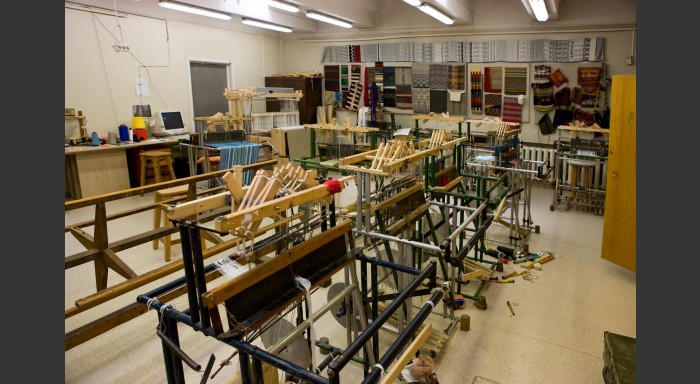Textile laboratory |
Malūnų str. 5, Vilnius |
|
|
Head of laboratory Vladas Daškevičius |
Mob. 8 657 28734 | vladas.daskevicius@vda.lt |
| Specialist for practical training of students Aleksas Gailieša | Mob. 8 606 55697 | aleksas.gailiesa@vda.lt |
VAA VF Art and Design Lab Textile Laboratory. Room No. 229
The room is specialized for computer embroidery technology. There are:
- Professional cutting table
- Domestic sewing machine
- Ironing table
- Domestic single needle computer embroidery machine
- Industrial 15-needle digital embroidery machine
Room No. 175
The room specializes in fiber, yarn, fabric dyeing, wool felting, pulp and screen printing technologies.
The room is equipped with:
- Professional electric stove with four burnes;
- Silkscreen washing bath;
- Silkscreen printing frames with nets, swipers;
- Household electric washing machine;
- Household electric clothes dryer;
- Hair dryer / blower;
Room No. 166
It is a multifunctional space for textile technology, dedicated to for:
- Classical and derived weaving technologies;
- Two-layer weaving;
- Preparatory weaving works;
- Tufting technology;
- Sewing machine;
- Computer embroidery;
- Sublimation;
- Knitting machine.
There are working means and equipment in the room:
- Height-adjustable vertical weaving frames;
- Height-adjustable vertical frames for base tensioning technology;
- Frames for vertical weaving;
- Four-shaft horizontal weaving loom (maximum weaving width 50 cm.);
- Electric machines for tufting technology (cut fluff, uncut fluff, fluff cutting, fluff smoothing);
- Means for preparation of the weaving process (vertical, horizontal throwers, gaps, chips, shooters, stretchers);
- Domestic single needle felting machine;
- Domestic sewing machine;
- Domestic sewing machine Overlock;
- Knitting machines (classes 3 and 5);
- Ironing table, irons;
- Domestic single-needle digital embroidery machines;
- Computer for digital embroidery with computer programs of embroidery;
- Heating press machine;
- Sublimation printer.
Room No. 232
The room is adapted for the following activities for:
- classical and derived weaving technologies;
- preparatory weaving works;
- multilayer weaving.
There are working means and equipment in the room:
- Four-shaft horizontal weaving loom(maximum weaving width 120 cm);
- Four-shaft horizontal weaving loom (maximum weaving width 100 cm);
- Horizontal weaving loom "TOIKA" 32 shaft, with two warp rollers, with computerized weaving control program (maximum weaving width 120 cm);
- Horizontal weaving loom "TOIKA" 16 shaft with computerized weaving control program (maximum weaving width 80 cm);
- There are three stationery computers with recorded computer weaving programs;
- Three stationary computers with computer programs of weaving (Ewavepoint).
There are 8 workplaces in each room of the Textile laboratory.
___
Students working in the Textile laboratory are provided with equipment and tools for various technological processes as described in the presentation of the laboratory’s capabilities.
All materials and tools necessary for the technological processes are provided to students in the laboratory, while lecturers are provided with what is necessary for their work functions:
- Weaving vertically and horizontally (white woolen, bleached and natural linen yarn, colored mixed yarn);
- Tufting technology (sewing fabric for the base, latex for gluing, white wool and mixed yarn);
- Sewing (sewing threads, scraps of various types of fabric);
- Silkscreen printing technology (white cotton, linen, mixed fabric, five color of pigments);
- Sublimation (polyester white fabric, pigment dyes for sublimation, sublimation paper);
- Dyeing, printing of fabrics (cotton, linen, silk white fabrics, five color of pigments);
- Computer embroidery (embroidery threads, cotton fabric, stabilizers, adhesives, embroidery machines);
- Knitting (knitting threads of various colors and types, knitting machines);
- Felting (needle felting, household felting machine, wool fiber);
- Portable hand and power tools.
Students are partially supplied with materials when carrying out their artistic experiments (according to point 7 of the “Work Rules of Textile Laboratory”, approved Rector‘s order No. VĮU-16, dated 2020- 02-14).






